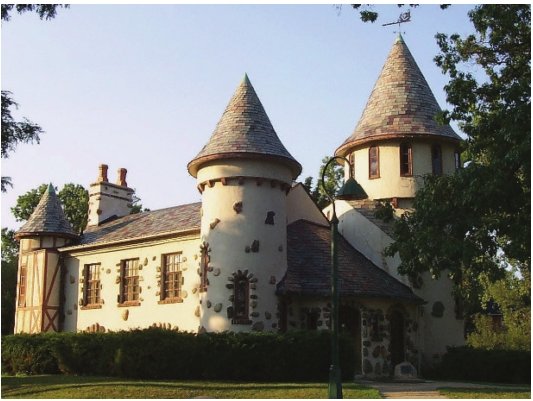
Once you’ve visited the castle of author James Oliver Curwood (1878-1927), built in Owosso on the banks of the Shiawassee River, you will have a better understanding of the man. At the turn of the 20th century, Curwood became the country’s first superstar author — penning 33 adventure books, too many magazine articles to count and movie after movie attributed to his work.
The three-story stone and stucco recreation of a Norman castle still seems a bit out of place in Curwood’s hometown.
Designed by Lansing architect William Chase as a writing studio and constructed in 1922, the castle has one large corner turret and two false turrets. There are no sleeping quarters.
A door befitting a castle opens to one large room on the first floor, which is anchored by a marble fireplace, bookcases and a moose head mounted above the fireplace. A bear rug lying in a seating area scowls at visitors.
A narrow winding staircase takes you to the second and third floors, which display artifacts from Curwood’s life and writing career. A basement room is dedicated to movies based on his work with bright movie posters decorating the walls.
Original paintings used to illustrate his novels are displayed on the first floor and in the small nook in the first floor turret.
Judith A. Eldridge in “God’s Country and the Man,” her biography of Curwood, writes: “The castle studio being built be side Abbie’s house was a quaint and incongruous structure for a small Midwestern city, but it fulfilled Jim’s romantic notions of a place to write his stories. He had never been commonplace himself and he wanted something unique.”
The “Abbie” is Curwood’s mother and yes, Curwood built his castle a stone’s throw away from his boyhood home where he began writing and submitting adventure stories to newspapers and magazines.
By the time Curwood was 18 years old in 1896, his first adventure story would run in the Detroit Journal. Some of his early adventure stories were set in Cuba, where he never stepped foot, and he reveled in recreating Indian battles that “may” have occurred nearby.
Although he didn’t graduate from high school, he attended the University of Michigan. As a published writer, he thought himself above the average student. He left U-M before graduating, taking a job as a reporter at the Detroit News-Tribune, a job he was soon fired from for getting a name in a crime article wrong.
By 1903, he made his first trip to Northern Canada, a favorite setting for most of his 33 adventure novels. He also became a major trophy game hunter amassing a large number of specimens. On one of his many trips to Canada, he renounced trophy hunting after a bear he shot and wounded walked away, sparing his life.
Curwood was a changed man and would dedicate the rest of his life to conservation and preservation activities both locally and nationally. He kept his trophy animals to remind him of how wrong he believed hunting for trophies was, according to Eldridge.
He used his national reputation and his prolific writing to help unseat an incumbent anti-conservation Michigan governor and was appointed to the State Conservation Board. In her biography, Eldridge carefully details Curwood’s writing career and his personal tribulations including.
Curwood is known today for his adventure novels set in northern Canada where he made many forays throughout his life. His leading characters were often wolfdogs or bears (“Kazan,” “Bear”) or Mounties as in “Philip Steele of the Royal North West Mounted Police.”
Curwood not only optioned his books for movies, but also wrote hundreds of movie treatments. The Museum has documented more than 230 movies which were adapted from his work.
Denise Grace, head docent at the Curwood Castle Museum, points to Rin Tin Tin as one of his creations.
When asked why he fell into obscurity compared to his contemporary Jack London, Grace offered the explanation that London’s work became part of school curriculums while Curwood’s was overlooked.
Each year Owosso holds a Curwood Festival that coincides with his June 12 birthday. Among other things Grace oversees a writing contest for young authors.
Grace said, “Curwood was more interesting of a character than any of the characters that he created.”
Curwood died young at 49 years from an infection, but he left behind a lifetime of great adventure tales.
Curwood Castle 224 Curwood Castle
Dr., Owosso, MI Tuesday-Sunday
1 p.m to 5 p.m. $5 for adults; $3 for children.
Support City Pulse - Donate Today!
Comments
No comments on this item Please log in to comment by clicking here